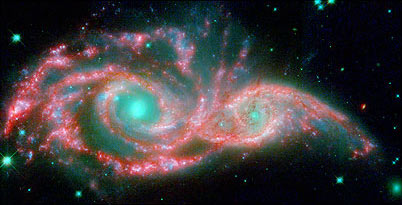As I sit here in my living room, laptop keeping me warm (and probably irradiating parts of me that are best left unirradiated), the sounds of “South Park” playing in the background, I feel pretty safe.
But it’s a lie, an illusion.
The Universe is a dangerous place. We sit here in the Milky Way, isolated and out of danger… for now. But other galaxies are out there. They can get close, and their immense gravity can distort our Galaxy, fling stars out like a dog shaking off water, rip out long streams of gas and stars, and then eventually merge with us.
What evidence do I have for this chilling scenario? For one thing, we see it happening in the Milky Way. Our Galaxy is actively eating at least one other one, for example. We’re also pretty sure that in 3 billion years, we’ll merge with the Andromeda galaxy too.
And, for the clincher, we just plain old see other galaxies colliding. The image above, just released by the Spitzer Space Telescope, shows two spiral galaxies named NGC 2201 (left) and IC 2163 (right). Each is similar to ours, except that they are in the process of colliding. The red color in the image is actually from infrared light, showing dust warmly glowing (the blue and green parts are from a Hubble image, and added together make the false-color image). See how the dust is all in the spiral arms? When the two galaxies passed each other, the gravity of each disturbed the other, causing clouds of gas and dust to collide, collapse, and form stars. This happens predominantly in the spiral arms, which is why they are so obvious in the image.
The two galaxies will pass each other, swing around due to gravity, and pass again. This will happen multiple times, until, about a half billion years from now, they will merge into one colossal galaxy. It’ll probably be elliptical in shape, like a football, the spiral arms distorted beyond recognition. Probably, the same fate awaits us when we merge with Andromeda.
A thought: In the image above, the two galaxies are superposed on the other. Can you tell which galaxy is in front of the other? No? Maybe this image will help:
That’s the Hubble image of the same galaxies that was used in the Spitzer image above (click on it for a higher-res version). See on the right, how the spiral arm from NGC 2207 cuts across the nucleus of IC 2163? In optical light, dust is dark, absorbing light behind it. Since we see the dark arm in front of IC 2163, NGC 2207 must be in front. If it were behind the smaller galaxy, we wouldn’t see that arm at all, because it would be blocked by dust in the other galaxy.
As usual, it’s the combined might of telescopes that see in different wavelengths of light that reveals clues about the goings-on of our Universe. And if you don’t think knowing this stuff is important, then just wait three billion years. When Andromeda is filling up the whole sky, and the Sun gets tossed out of the Galaxy like you’d flick some noisome goo off your finger, well, you’ll be sorry then! Or maybe you’ll have other things on your mind. Or maybe, realistically, it won’t happen until three billion years from now, so maybe it’s not so pressing.
But it’s cool. Don’t ever underestimate that.’
